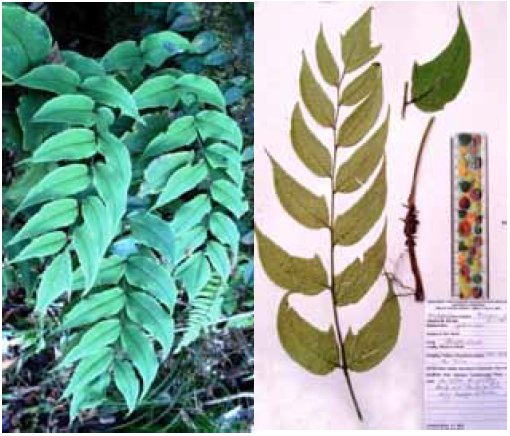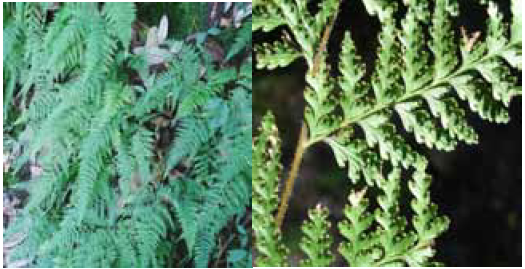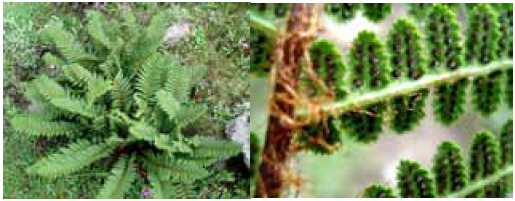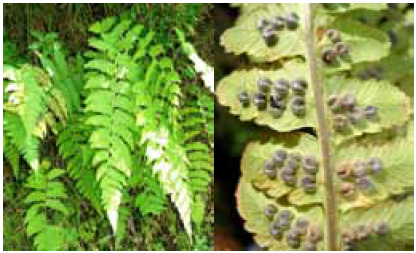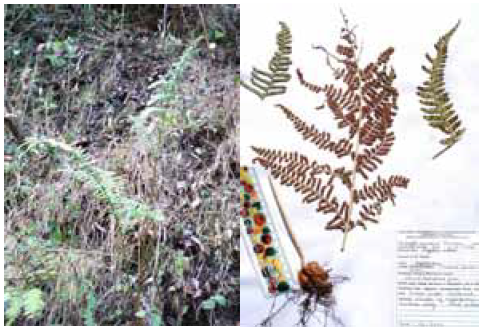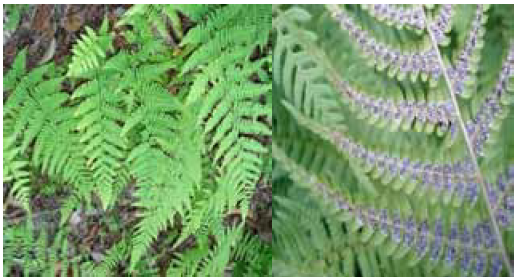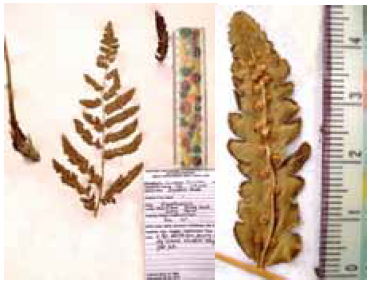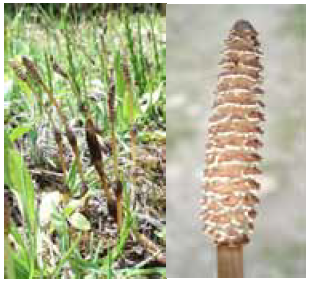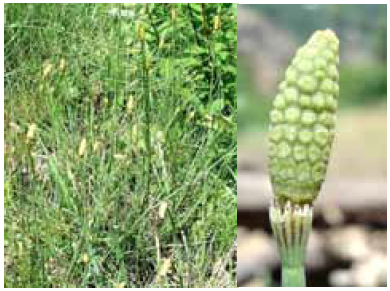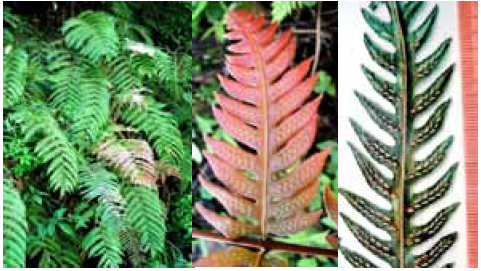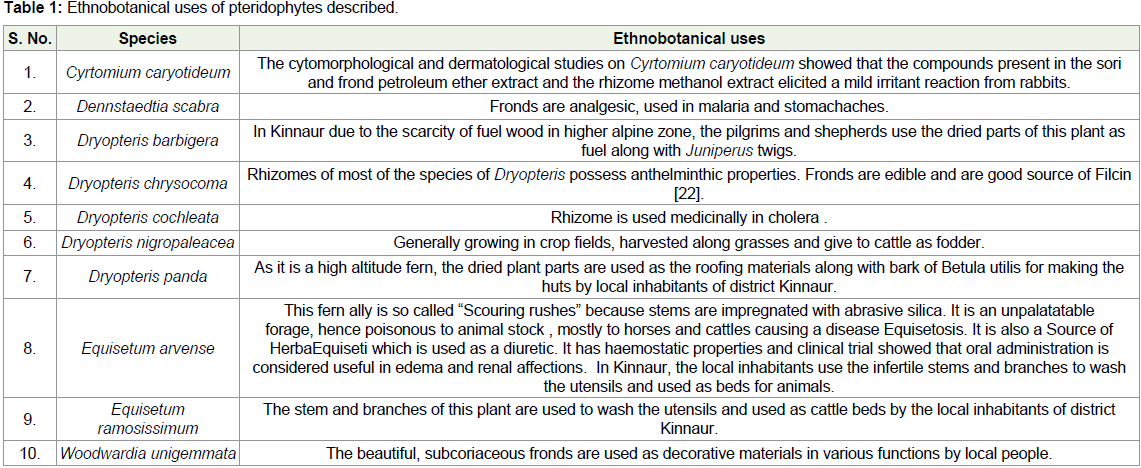Research Article
Morphological and Ethnobotanical Aspects of Ten Common Species of Ferns and Fern Allies Belonging to Families Dennstaedtiaceae, Dryopteridaceae, Equisetaceae & Blechnaceae from District Kinnaur of Himachal Pradesh
HC Negi1*, Nitesh Kumar2, Ruchi Negi3 and Stuti Rawat4
*Corresponding author: H.C. Negi, Department of Botany, Thakur Sen Negi Government College, Reckong Peo
(H.P.) 172107 E-mail: hcn0918@gmail.com
Copyright:© Negi HC, et al. 2023. This is an open access article distributed under the Creative Commons Attribution License,
which permits unrestricted use, distribution, and reproduction in any medium, provided the original work is properly cited.
Article Information: Submission: 16/12/2022; Accepted: 26/01/2023; Published: 31/01/2023
Abstract
Extensive documentation of ethnobotanically important pteridophytes remains lacking though vascular cryptogams are used by indigenous people to a
great extent. Therefore, this paper gives an account of the useful pteridophytes of the Kinnaur district of H.P. The present study focuses on the morphological
and ethnobotanical study of 10 common species of ferns and fern allies viz Cyrtomium caryotideum, Dennstaedtia scabra, Dryopteris barbigera, Dryopteris
chrysocoma, Dryopteris cochleata, Dryopteris nigropaleacea, Dryopteris panda, Equisetum arvense, Equisetum ramosissimum & Woodwardia unigemmata.
The documentation of these pteridophytes may be helpful in preserving them by local people. This may also help to popularize their uses leading to the
bioprospection of these resources.
Keywords
Kinnaur; Himachal Pradesh; Pteridophytes; Fern and fern allies; Ethnobotanical uses
Introduction
India ranks sixth among the 12 mega biodiversity centers of
the world [1,2] and is acknowledged as the Botanical Garden of
the World and has 3 biodiversity hotspots namely Andaman and
Nicobar Islands, Eastern Himalayas and Western Ghats. India
is renowned for having many medical systems worldwide, with
ayurveda having about 250,000 registered medical practitioners [3].
Traditional medicines were used by many native communities in cultural, ecological, and historical aspects India has a pteridophytic
flora as it has diverse topography, varying climatic conditions distinct
geographical positions with numerous migration-flows of species of
different phytogeographical elements meeting in various parts of the
country [4].
Pteridophytes, are seedless tracheophytes that first appeared
during the Carboniferous period and are second to angiosperms in
the world with 13,600 species around the world [2,5,6]. They are shade and moisture-loving and thrive in moist temperatures and exist in
areas with high altitudes. Asia represents about 4,500 pteridophytes,
one-third of the total number existing in the world Indian flora
consists of 67 pteridophytic families with 191 genera comprising
more than 1000 species with 47 endemic ferns [6].
Theophrastus (327–287 BCE) and Dioscorides (50 CE) mentioned
pteridophytes possess medicinal properties for the treatment of
different health problems [7]. Pteridophytes have been used by
indigenous people for a long time but their ethnobotanical uses
have yet not been documented to a large extent. Inhabitants of tribal
communities in India, China, and the Philippines use these ferns for
ethnobotanical purposes. Ferns belonging to the Microsorum genus
are used to make medicines by people in the Pacific islands [8,9].
Indian subcontinent exhibits high biodiversity richness and
many traditional healthcare systems. Several forest products are
used by indigenous people. Thus, the conservation of indigenous
knowledge is necessary in national and international perspectives
which will lead to the acknowledgement of progressive trends in
indigenous knowledge[10].[11] mentioned 160 species of medicinal
pteridophytes of our country having pharmacological properties [12].
Materials and Methods
Himachal Pradesh is a mountainous state situated in northern
region bordered by Jammu and Kashmir and Ladakh in the north,
in west by Punjab, Haryana in southwest, in the southeast by
Uttarakhand and shares a narrow border in south to Uttar Pradesh.
Kinnaur District is located in the north-easternmost part of
Himachal Pradesh with an area of 6520 sq. meter. Satluj river divides
the district equally and enters the district from north-west and leaves
on the western boundary. Kinnaur is situated on the banks of river
Satluj from Northern latitude 31-05’-50’’ to 32-05’-15’’ and eastern
longitudes 77-45’ to 79-00’-35’’ East longitudes.Ngari region of
western Tibet forms eastern boundary of Kinnaur; Zaskar Mountains
separate it from Tibet. The district is separated from Uttarkashi
district of Uttarakhand on south by Dhaula Dhar Range and Rohru
tehsil of district Shimla. Kullu and Rampur regions are separated on
western side by Srikhand Dhar. Rivers Spiti and Parachu separate
Kinnaur from Lahaul and Spiti in north. near international boundary
with Tibet. Cedrus deodara, Juglans regia, Pinus gerardiana, Pinus
roxburghii, Rhododendron arboreum are common tree species
found locally. July to October are the best months for the collection.
Collection of ferns and fern allies was done during this period as
monsoon rains occur and these plants reach maturity or become
fertile. During winter period either only wintergreen species survive
or they remain dormant to resume active growth in the next monsoon
season.
Standard methods were adopted for collection, preservation &
identification of the plants. The plants were photographed & their
characteristic features were noted in the field. Five herbarium mounts
of each of these plants were also prepared for record & identification.
The collected plants were identified & described according to latest
International Rules of Botanical Nomenclature [13,14]. Metric
system has been adopted throughout the work.
Classification given by [15] & followed by [16] for identification
of pteridophytes; with revisions according to updated rules and
regulations have been applied. The collected and identified plants
are illustrated by following the latest International Rules of Botanical
Nomenclature. For each plant common and vernacular names
available in the literature, etymology, citations, morphological
features, flowering and fruiting season, specimens examined, habitat,
economic and ethnobotanic value of some ferns and coloured
photographs are also presented. Metric system has been adopted
throughout the work. In addition to several other references [13]
and latest International Code of Botanical Nomenclature have been
followed for plant nomenclature. Classification given by [13, 15] and
followed by [14] for pteridophytes have been adopted.
Observations
Extensive field visits were made to the study sites of district Kinnaur
of Himachal Pradesh for sample collection. 10 species belonging to 5
genera of 4 families have been documented in this paper. 1 species is
used as a fuel wood, 2 species are used as fodder for livestock and 4
species are used as medicines. All of these pteridophytic species have
been reported for the first time in this area. Dryopteridaceae is the
dominant family with 2 genera (6 species) and Dennstaedtiaceae (1
species), Equistaceae(2 species) and Blechnaceae(1 species).
Results and Discussion
Cyrtomium caryotideum (Wallichex Hook. &Grev.) Presl.
syn. Aspedium caryotideum Wall.,Cyrtomium falcatum Swartz
var. caryotideum (Wallichex Hooker &Greville) BeddomeFamily:
Dryopteridaceae Cyrtomium caryotideum (Wallich ex Hooker
&Greville) Presl. Tent. Pterid. 86. Pl. 2. f.26. 1836; Dhir, Ferns of
North-West. Himal. 78. 1980; Khullar, Illust. Fern Fl. W. Himal. II:
256. f.91. 2000;Pande & Pande, Illust. Fern Fl. Kumaon Himal. II:
196. f.66. 2002; Pande & Pande, Illust. Fern Fl. Kumaon Himal. 1: 249
2003; Chandra, Ferns Ind. 166. 2007. Aspedium caryotideum Wall.,
Numer. List No. 376. 1828. Aspedium falcatumsensu Clarke, Trans.
Linn. Soc. Lond. 2 Bot 1: 512. 1880, pro parte; non-Hooker&Greville
1828.
Morphological aspect: Size 45-95 cm long. Rhizome is short and
thick, robust, wrapped by tenacious leaf bases, crowded scales, scales
dark-brown, concolorous, longer than its width /ovate. Stipes 15-30
cm long, diam. 0.1-0.2 cm, pale-brown with dark-brown base, densely
scaly at the base, with dispersed scales and fibrils, scales longer than its
width to ovate or lance-shaped, dark brown. Rachis fibrillose, broad
scales absent, fibrils more prominent at pinna-junction. Lamina
pinnate, 30-60 x 10-20 cm, imparipinnate, base truncate, texture
sub-coriaceous to leathery, smooth, petiole decreasing in length in
the upper pinnae, leathery, ovate-lance shaped, falcate, caudate, acute
or obtuse at base, strongly auriculate on the upper or both sides,
acroscopic base extended into a long sharp auricle, terminal pinna
generally the largest. Veins reticulate, darkened and prominent,
primary veins arising from the costa of the pinna almost parallel
to each other extending near to the margin, dividing pinnately 1-3
times; veinlets inwardly directed, anstomosing, areolae hexagonal.
Sori indusiate, round, numerous larger, scattered. Indusium palebrown,
large, round, flat, thin, peltate, more or less caducous, smooth,
margin fimbriate. Sporangia spherical to elliptical, with 15-17 vertical
annular cells and having considerably long stalk. Spores round,
brown 42-45.5 x 49-56 μm, perinate, perine faintly reticulate. Fertile
season: September-February.
Specimens examined: Chaura forest (Kinnaur, 2200 m), 1.1.2019,
H.C.Negi 320.
Habitat: A beautiful terrestrial fern which rarely grows on humus
rich soils in damp shaded nallahs and hilly slopes under the shades
of angiospermic bushes. Distribution: Bhutan, China, Japan, Nepal,
Pakistan. Philippines, Tibet, Vietnam, W. Himalaya, India: Jammu
& Kashmir, Uttarakhand, Himachal Pradesh: Chamba (Dalhousie),
Kulu (Manali), Shimla hills (Chachpur, Glen, Theog), Solan
(Kandaghat, Mt. Karol). Altitude: 2000-2400 m.
Notes: 1) Chromosome number: triploid apomict, n = 30 [17].
2) Cyrtomium caryotideum has been collected and described for
the first time from district Kinnaur of Himachal Pradesh.
Dennstaedtia scabra Wall. ex Moore syn. Dicksoniascabra Wall.
Family: Dennstaedtiaceae
Dennstaedtia scabra Wall. ex Moore, Index Fil., 307. 1861;
Beddome, Hbk Ferns Brit. Ind. 24. t. 124. 1883;Baishya& Rao, Ferns
& Fern-allies of MeghalayaState, Ind. 88. 1982;Dixit, Cens. Ind.
Pterid. 94.1984; Khullar, Illust. Fern Fl. W. Himal. I: 360. f. 128. 1994;
Borthakuret al.,Illust. Man. Ferns Assam 251. f.116. 2001; Pande
& Pande, Pteridology in W. Himal. (Kumaun). 74. 2002; Pande & Pande, Illust. Fern Fl. Kumaon Himal. II: 98. f.28(i). t.25. 2002;
Chandra, Ferns Ind. 97. 2007.Dicksonia scabra Wall., Numer. List
no. 2173. 1829. nom. nud. (Wall. ex Moore) Clarke, Trans. Linn. Soc.
Lond. 2 Bot. 1: 436. 1880; Hope, J. Bomb. nat. Hist. Soc. 13: 28. 1900.
Morphological aspect: Size medium, 18-22 cm. Rhizome long
crawling type, slender, diam. 0.3-0.4 cm, densely hairy, brown, 5-10
celled long, acicular, scaly, scales dull-brown in color, 0.4-0.6 x 0.1-
0.2 cm. Stalks 6-18 cm in length, diam. 0.1-0.3 cm, reddish-brown,
± thick, rough, densely hairy at base, becoming sparsely hairy higher
up, hairs brown, 9-13 cell long. Rachis often wavy, brown, hairs as on
stipe. Lamina 2-3 pinnate, 15-50 x 9-25 cm, deltate or broad lanceshaped,
with a surface which is herbaceous, dark olive-green, both
surfaces sparsely hairy, hairs white, glistening. Pinnae 6-10 pairs,
up to 5-7.5 x 2-3.5 cm, close together, alternate, with stalk(in well
developed plants) or sessile, deltate. Pinnules 1.5-2 x 0.4-0.6 cm,
lower pinnules lobed extensively to the costa. Pinnules many, longer
than its width-deltate. Veins free, hairy, costa and costules hairy.
Sori indusiate, subglobose, 2-6 per lobe, terminal on the margin of
the lobes. Sporangia 11-12 celled annulus, black coloured. Indusia
cup-shaped, smooth. Spores yellow-brown, 34.5-28.5 x 28-38.5 μm,
tetrahedral trilete, non-perinate, exine smooth. Fertile season: May-
November.
Specimens examined: Rispa (Kinnaur, 2500 m), 17.6.2017, Ruchi
Negi 208.
Habitat: Well flourished in small cliffs or steep slopes in deep
sheltered stream gulleys and humus rich forest floor of Pinus
wallichiana. Distribution: Burma, China, Japan, Malaysia, Nepal,
Thailand, Taiwan, Vietnam, W. Himalayas. India: Darjeeling hills,
Meghalaya, Sikkim, Uttarakhand (Chamoli-Garhwal Dehradun,
Mussoorie, Tehri-Garhwal) [18]. Himachal Pradesh: Shimla
(Chadwick fall, Tutikandi). Altitude: 1600-2700 m.
Notes: 1) Chromosome number: n = 33, 34 (17).
2) Dennstaedtia scabra has been collected and described for first
time from district Kinnaur of Himachal Pradesh
Dryopteris barbigera (T. Moore ex Hooker) O. Ktze. syn.
Nephrodium barbigerum T. Moore ex Hooker Family: Dryopteridaceae
Dryopteris barbigera (T. Moore ex Hooker) O. Ktze., Revis. Gen.
Pl.2: 812. 1891; Dhir, Ferns NW. Himal. 66. 1980; Dixit, Cens. Ind.
Pterid. 149. 1984 [19]; Khullar, Illust. Fern Fl. W. Himal. II: 275. f.96.
2000; Pande & Pande, Pteridology in W. Himal. (Kumaun) 117. 2002;
Clarke, Trans. Linn. Soc. Lond. 2 Bot. 1: 522. 1888; Hope, J. Bomb.
nat. Hist. Soc. 14: 731. 1905. Lastrea barbigera (T. Moore ex Hooker)
Beddome, Ferns Brit. Ind. 246. 1883. Nephrodium falconeri Hooker,
Sp. Fil. 4: 123 pl. 254. 1862. Lastrea falconeri (Hooker) Beddome,
Ferns Brit. Ind. 1: 41 pl. 41. 1865. Dryopteris falconeri (Hooker)
Kuntze, Revis. Gen. pl. 2: 812. 1891.
Morphological aspect: Size medium, 42-47 cm. Rhizome woody,
massive, horizontal, thick, scaly. Stipes 12-14 cm long, diam. 0.2-
0.25 cm, thick, base brown, stramineous higher up, with glands,
with dense scales and fibrils, scales dull to reddish-brown, generally
ovate-lance-shaped or lance shaped, large, one Lamina bi pinnate,
large, 25-55 x 15-25 cm, ovate-lance shaped to oblong-lance shaped, broadest above the reduced base, texture densely herbaceous, ventral
and dorsal surfaces scaly with narrow scales, upper surface sparsely
scaly. Pinnae 15-20 pairs, close, 9-12 x 1.5-2.5 cm, sub-opposite
(lower part), alternate (higher up on lamina), short with stalk, lance
shaped, lower 2-3 pairs of pinnae gradually reduced in size, lowest
pair of pinnae the shortest. Pinnules many, 10-15 pairs, 1.5-2 x 0.4-
1.2 cm, sessile, symmetrical, lance shaped the lower lobes being
longer, serrated with prominent slightly mucronate teeth. Veins
6-9 pairs per pinnule (depending upon the length of the pinnule),
in groups of 3-4, corrresponding to the pinnule lobes, costae and
costules have dense scales and fibrils, scales dull-brown, concolorous,
narrow lance shaped, margin smooth or slightly hairy bordered,
apices long-caudate. Sori with indusium, tiny, spherical, sub medial,
close to costa, 4-6 pairs both ways to the costule. Indusia dull-brown,
reniform, tiny, thin, caduceus. Sporangia with 16-18 annulus cells.
Spores dark- brown, yellow, globose, 35-38.5 x 45.5 μm, perinate,
perine folded. Fertile season: July-October.
Specimens examined: Kinner Kailash (Kinnaur, 6500 m),
13.8.2016, H.C. Negi 211; Lippa (Kinnaur, 2750 m), 14.7.2017, H.C.
Negi 253;
Habitat: A high altiude fern prefers to grow in open exposed
meadows, along the sides of riverlets and in the crevices of rocks.
Distribution: Afghanistan, Bhutan, China, Nepal, Pakistan, Taiwan,
Tibet, Yunnan, W. Himalayas. India: Kashmir (Anantnag, Baramula,
Pir Panjal, Poonch), Sikkim, Uttarakhand (Almora, Badrinath,
Kedarnath, Kidarkanta, Mastura, Nag Tibba, Pithoragarh,).
Himachal Pradesh: Chamba, Kangra (Dharmsala, near Triund),
Kullu (Dibibokri Nal), Lahaul (Khoksar), Shimla Hills (Ghor Jubbal,
Matiana). Altitude: 3000-6500 m.
Notes: 1) Chromosome number: diploid sexual n = 41 [20]
2) Dryopteris barbigera has been collected and described for the
first time from district Kinnaur of Himachal Pradesh.
Dryopteris chrysocoma (Christ) C. Chr. subsp. Chrysocoma syn.
Aspidium chrysocomum (Christ.) Christ. Family: Dryopteridaceae
Dryopteris chrysocoma (Christ) C. Chr., Index Fil 257. 1905.
subsp. chrysocoma; Dhir, Ferns NW. Himal. 67. 1980; Baishya& Rao,
Ferns & Fern-allies of Meghalaya State, Ind. 126. 1982; Dixit, Cens.
Ind. Pterid. 149. 1984; Khullar, Illust. Fern Fl. W. Himal. II: 284
f.100. 2000; Pande & Pande, Illust. Fern Fl. Kumaon Himal. 1: 255.
f.61. 2003; Chandra, Ferns Ind. 173. 2007. Aspidiumfilixmas Swvar.
chrysocomum Christ, Bull. Herb. Boiss. 6: 966. 1898. Nephrodium
chrysocoma (Christ) Hand.-Mazz, Symb. Sin. 6: 24. 1929. Dryopteris
chrysocoma (Christ) C. Chr. var. major Ching, Bull. Fan Mem. Inst.
Biol. (Bot.) 8: 438 . 1937. Dryopteris chrysocoma (Christ) C. Chr. var.
alpina Ching, Bull. Fan Mem. Inst. Biol. (Bot.) 8: 438. 1938. Dryopteris
chrysocoma (Christ) C. Chr. var. squamosa (C. Chr.) Ching, Bull Fan
Mem. Inst. Biol. (Bot.) 8: 438. 1938.
Morphological aspect: Size 37-47 cm in length. Rhizome erect or
short creeping decumbent, thick, branching to form several crowded
apices, scaly, scales 1.1-1.3 x 0.1-0.2 cm. Stipes 10-15 cm in length
and 0.3 cm in diam., one third of the laminar length, stramineous.
stipe base has a bunch of dense scales, which has sparse scales and
with fibrils near the apex of stalk, scales at stipe base are pale to
dull brown, concolorous transparent, large up to 3.5 cm long, stipe
becoming muricated due to persistent bases of fallen scales. Rachis
stramineous, bearing scattered fibrillae with some light brown
scattered narrow scales and bearing only scattered fibrillae further up.
Lamina 2-pinnate, size variable, 15-55 x 2.5-18 cm, lance shaped or
slightly ovate-lanceolate, but base slightly truncate, texture somewhat
densely herbaceous turning yellowish on approaching the end of
the growing season, upper surface is smooth. Pinnae numerous,
up to 25-28 pairs, 2.5-12 x 1.5-2.8 cm, alternate, with a short stalk
or almost sessile, basal 1 or 2 pairs short and distant,lance-shaped.
Pinnules 8-14 pairs, 0.8-2.5 x 0.5-0.8 cm, opposite to alternate, sessile;
very small and narrow. Sori indusiate, markedly large and round,
close to the costule, 4-5 dyads in one row on both side of the costule,
crowded, whole frond fertile. Sporangia with 16-18 celled annulus,
light yellow colored. Indusia light brown which becomes grey on
maturing, reniform, large, thick, diam. up to 0.25 cm persistent and
not or hardly shriveling, smooth, margin entire, sinus broad. Spores
generally circular in shape, dark brown, perine folded granulose.
broad. Fertile season: June-November.
Specimens examined: Nichar (Kinnaur, 2200 m), 12.8.2015, H.C.
Negi 113, Katgaon (Kinnaur, 2200 m), 14.9.2016, H.C. Negi 114; and
Rupi-Shorang way (Kinnaur, 2400 m), 25.9.2016, H.C. Negi 210.
Habitat: Rock crevices and on the floor of pine forest.
Distribution: Bhutan, Burma, China, Nepal, Pakistan, Philippines,
W. Himalayas. India: Arunachal Pradesh, Darjeeling hills, Kashmir
Madhya Pradesh, Meghalaya, Sikkim, Uttrakhand,Himachal Pradesh:
Chamba (Dalhousie), Kangra (Dharmsala), Kullu (Hadimba temple,
Jalori pass, Manali, Marhi, Solang nallah), Shimla hills (Baghi,
Chachpur, Chail, Craignano, Matiana, Narkanda, Naldera, Retreat).
Notes:1) Chromosome number, diploid sexual, n = 41 [20]
2) Dryoptris chrysocoma has been collected and described for
the first time from district Kinnaur of Himachal Pradesh.
Dryopteris cochleata (Buch.-Ham. ex D. Don) C. Chr. syn.
Nephrodium cochleatum Buch.-Ham. ex D. Don. [21] Family:
Dryopteridaceae
Dryopteris cochleata (Buch.-Ham. ex D. Don) C. Chr., Index Fil.:
258. 1905;Dhir, Ferns NW. Himal. 68. 1980; Baishya& Rao, Ferns &
Fern-allies of Meghalaya State, Ind. 126.1982; Dixit, Cens. Ind. Pterid.
150. 1984; Khullar, Illust. Fern Fl. W. Himal. II: 288. f.101. 2000;
Borthakuret al., Illust. Man. of Ferns Assam. 401. f.196. 2001; Pande
& Pande, Pteridology in W. Himal. (Kumaun). 118. 2002; Pande &
Pande, Illust. Fern Fl. Kumaon Himal. II: 201. f.67(v). 248. t.17. 2002;
Pande & Pande, Illust. Fern Fl. Kumaon Himal. 1: 256. 2003; Chandra,
Ferns Ind. 173. 2007. Nephrodium cochleatum Buch.- Ham. ex D.
Don, Prodr. Fl. Nepal.; 6. 1925; Clarke, Trans. Linn. Soc. Lond. 2 Bot.
1: 521. 1880; Hope, J. Bomb. nat Hist. Soc 14: 734. 1903.Nephrodium
filixmas Pr. var. cochleata (Buch.-Ham. ex D. Don. Beddome, Ferns S.
Ind.. Suppl. 33. 1876; Hbk. Ferns Brit. Ind: 250. 1883. Aspedium filixmas
Sw. var. cochleatum ( Buch.-Ham. ex D. Don) Christ. Farnkr.
Erde. 257. 1897.
Morphological aspect: Size large, 50-95 cm. Rhizome sub erect
or short creeping, decumbent, horizontal or ascending at the apex,
thick and scaly. Fronds dimorphic, with distinct sterile and fertile
ones. Infertile fronds numerous, spread out, with one or more fruitful
fronds standing unbendingly in the central region. Stipes 20-40 cm
long, stramineous, lance-shaped, apices caudate, higher up on stipe
scales very scattered and narrow, or stipe nearly smooth. Rachis very
sparsely scaly and fibrillose, fibrils dull mostly at the junction between
the pinna costae and rachis. STERILE FRONDS: Lamina pinnate and
bipinnatifid or bipinnate, 25-75 x 45-55 cm, lance-shaped or almost
triangular base widely truncate, texture like herb to subcoriaceous,
upper surface somewhat glossy, smooth, diamorphic. Pinnae 12-16
pairs, margin deeply lobed to the costa, lowest pair of pinnae equally
long or shorter than the pair present above, distant. Pinnules 10-12
pairs, 1.5-2.5 cm broad, lance-shaped, cuneate, at their acroscopic
bases and cuneate to deccurent to a narrowly winged costa, apices
obtuse or acute, margins shallowly lobed, each lobe bearing an acute
tooth. FERTILE FRONDS: Lamina 22-75 x 6-14 cm, erect, lanceshaped.
Pinnae 10-14 pairs, 5.5-10.5 x 1.5-2.5 cm broad, ascendant,
subopposite to alternate, with a short stalk, triangular-lance-shaped.
Veins are paired, 20 in each pinnule, forked, costae sparsely fibrillose.
Sori indusiate, very large, markedly crowded, wrapping the whole
lower surface of the fertile lobe fully, round, medial, 4-7 pairs in one
row on both side of the costule. Indusia dull brown, reniform, large,
prominent, thick, shriveling, persistent, smooth, margin entire, sinus
broad. Sporangia dull brown, large, with 12-16 celled annulus. Spores
brown, 31.5-38.5 x 42-52.5 μm, perinate, perine folded. Fertile season: Almost throughout year.
Specimens examined: Chaura forest (Kinnaur, 1800 m),
10.2)2018, H.C. Negi 234.
Habitat: Moist and damp shades of bushes, along road sides
and corners of crop fields. Distribution: Bali, Bangladesh, Bhutan,
Burma, W. Himalayas. India: Bihar, Darjeeling hills, Jammu &
Kashmir, Madhya Pradesh, Maharashtra, Meghalaya, Nagpur, Orrisa,
Pachmari, Sikkim, South India, Uttarakhand, Himachal Pradesh:
Chamba (Dalhousie), Kangra (Dharmshala), Mandi, Kullu, Shimla
(Chail, Shogi, Taradevi). Altitude: 900-1800 m.
Notes: 1) Chromosome number, diploid sexual, n = 41 [20]
2) Dryopteris cochleata has been collected and described for the
first time from district Kinnaur of Himachal Pradesh.
Dryopteris nigropaleacea (Fraser-Jenkins) Fraser-Jenkins syn.
Dryopteris pallida (Bony) C.Chr. apud. Maire &Petitm. Family:
Dryopteridaceae
Dryopteris nigropaleacea (Fraser-Jenkins) Fraser-Jenkins, Bolm.
Soc. Brot.II, 55: 238. 1982. Khullar, Illust. Fern Fl. W. Himal. II: 314.
f.111, 112. 2000; Pande & Pande, Pteridology in W. Himal. (Kumaun).
120. 2002; Pande & Pande, Illust. Fern Fl. Kumaon Himal. II: 204. f.67
(viii). 2002; Pande & Pande, Illust. Fern Fl. Kumaon Himal. 1: 347.
2003; Nephrodiumfilix-mas Rich. var. narmalis Clarke, Trans. Linn.
Soc. Lond. 2 Bot. 1: 519. 1880, pro parte.
Morphological aspect: Size large, 55-70 cm in length. Rhizome
long, erect, thick, scaly, scales 0.7-0.9 x 0.2-0.3 cm. Stipes 20-40
cm long, diam. 0.2-0.5 cm, stramineous to light-brown, stipe base
has dense scales and fibrils, scales being dark-brown or blackish,
of the same colour, broadly ovate-lance shaped, margin sometimes
have small tooth-like protrusions, apex caudate, scales disperse,
narrower, light colored, small sized as higher up on the stipe.
Rachis stramineous, almost smooth or with some discreet pale
coloured fibrilis and imperfect ephemeral scales, scales dull-brown,
concolorous, linear-lanceolate, margin with short projections, apex
long- caudate. Lamina 2-pinnate, 25-55 cm long, diam. 15-22 cm
broad, narrowly triangular-lance-shaped. Pinnae 12-20 pairs, 7-18 x
2-3.5 cm, contiguous, alternate, with a short stalk, becoming subsessile
or without a stalk higher up on lamina, elongated triangular-lanceshaped,
apex caudate, and pair at lower end or few pairs following it
may the largest. Pinnules 10-15 pairs, the lowest few with short stalk,
rest becoming winged, elliptical longer than its width, partly curved,
with acute or rounded apex, margin with lobes of 4-6 pairs of circular, or circularly shortened lobes with sharp tooth. Veins in a pinnule 4-8
pairs, pinnate, veinlets curved, most forked, running into the teeth of
the lobes but stopping short of the margin. Sori indusiate, tiny and
round, medial, present 5-7 pairs per pinnule, in one row on both
side of ridge. Indusia brown, reniform, tiny, thin, shrivelling up at
maturity, persistent, smooth, margin entire, sinus narrow. Sporangia
with 16-18 celled annulus. Spores dark-brown, globose, 30-35 x 31-39
μm, perinate, perine dull-brown, thin. Fertile season: May-October.
Specimens examined: Powari (Kinnaur, 2050 m), 10.6.2017,
Ruchi Negi, 16; Asrang (Kinnaur, 2500 m), 11.7.2018, H.C. Negi 225.
Habitat: Prefers to grow in the dense forest floor of Alnus and
Pinus sp. and even in the Apple orchard fields. Distribution: Pakistan,
West Nepal, W. Himalayas. India: Jammu & Kashmir (Gilgit,
Kishtwar, Pahlgam, Rajori-Uri, Sanasar, S), Uttarakhand (Brahmkhal,
Chamoli- Gaurikund, Hemkund, Mussoorie,). Himachal Pradesh:
Chamba (Dalhousie), Kangra (Dharmsala), Kullu (Manali), Shimla
hills (Anandale, Baldwin, Chachpur, Chail, Glen, Kufri, Mashobra,
Mt. Jakho, Naldera), Solan (Barog, Mt. Karol). Altitude: 1900-2500 m.
Notes: 1) Chromosome number, diploid sexual, n = 41 [20]
2) Dryopteris nigropaleacea has been collected and described for
first time from district Kinnaur of Himachal Pradesh.
Dryopteris panda (Clarke) Christ. syn. Lastreafilix-mas Pr. var.
panda (Clarke) Beddome. Family: Dryopteridaceae
Dryopteris panda (Clarke) Christ. Bull. Acad. Int. Geogr. Bot.
Mans. 19: 175. 1909;Dhir, Ferns of NW. Himal. 63. 1980;Khullar,
Illust. Fern Fl. W. Himal. II: 313. f.113. 2000;Pande & Pande,
Pteridology in W. Himal. (Kumaun) 121. 2002; Pande & Pande, Illust.
Fern Fl. Kumaon Himal. II: 205. f.67(ix). 2002; Pande & Pande, Illust.
Fern Fl. Kumaon Himal. 1: 259. 2003; Chandra, Ferns Ind. 182. 2007.
Nephrodium filix-mas Rich var. panda Clarke, Trans. Linn. Soc. Lond.
2 Bot 1: 519. 1880. Lastrea filix-mas Pr. var. panda (Clarke) Beddome,
Hbk. Ferns Brit. Ind. 251. 1883. Nephrodium pandum (Clarke) Hope.
J. Bomb. nat. Hist. Soc. 12: 623. 1899; 14: 623. 1901. Dryopteris filixmas
(L) Schott. subsp. panda (Clarke) C. Chr. ex Ching, Bull. Fan.
Mem. Inst. Biol. Bot. 8: 419. 1938.
Morphological aspect: Size medium, 25-55 cm long. Rhizome
long, erect, woody, massive, thick, scaly, scales dark colored, 1.5-2
cm in length, diam. 0.1-0.5 cm [22]. Stipes 10-25 cm in length, diam.
0.1-0.2 cm, equal to lamina or longer, with dark-brown base, with
straw, thick, stipe base scaly, higher up stipe becoming has sparse
scales, few in number, dull concolorous, lance shaped or ovate-lance shaped, margin entire, apex caudate. Rachis stramineous, sparsely
scaly, with small scales, dull in colour, apex is caudate, higher up
on rachis scales fewer and smaller. Lamina pinnate, 15-30 x 12-14
cm, sometimes narrowly lance shaped with a truncate base, texture
densely herbaceous, upper surface hairless and smooth. Pinnae 10-
15 pairs, 6-9 x 1-5-2 cm wide, close, alternate, nearly sessile, lance
shaped, falcate, base much broadened, apex caudate, margin lobed
1/3 to 1/2 or slightly more to the costa. Pinnules 5-8 pairs, 0.4-0.7
x 0.2-0.3 cm, rounded-shortened, apex sharply toothed, margin
sub-spinulose, serrulate, never pinnate. Veins 4-6 pairs per pinna
lobe, pinnate, costae and costulesdisperely scaly, scales light-brown,
concolorous, long, linear. Sori with indusium, big, circular, almost
on the principal costa, 1 or 2 sets per lobe near to base. Indusia light
brown, kidney-shaped, large, diam. 0.2 cm, thin like a membrane,
smooth, margin entire, sinus broad. Sporangia with 12-16 celled
annulus. Spores dark-brown, 35-38.5 x 42-49 μm, perinate, perine
folded. Fertile season: June-October.
Specimens examined: Barang Kanda (Kinnaur, 4600 m),
10.7.2000, H.C. Negi 302
Habitat: This high altitude fern prefers to grow in xeric condition
in the open meadows above the tree line and in between the huge
stone pieces. Distribution: China, Nepal, Tibet, W. Himalayas.
India: Darjeeling hills, Kashmir (Muzaffarabad, SudenGali), Sikkim,
Uttarakhand (Almora, Badrinath, Chamoli-Garhwal, Gangotri, Gori
valley, Tehri-Garhwal, Trijuginarayan, Uttar-Kashi, Yamunotri).
Himachal Pradesh: Chamba (Shaol forest), Kangra (Dharamsala,
near Triund), Kullu (Manali, Rohtang Pass), Shimla (Jakhu), Sirmaur.
Altitude: 2500-3400 m.
Notes: 1) Chromosome number, diploid sexual, n = 41 [20]
2) Dryopteris panda has been collected and described for the
first time from the district Kinnaur of Himachal Pradesh.
Equisetum arvense Linn. Family: Equisetaceae
The common or field horse tail, scouring rushes1.
Equisetum arvense Linn. Sp. Pl. 2: 1050. 1753; Milde, Mon. t.1-3;
Hook., Brit. Ferns, t.60; Engl. Bot. ed. iii. t. 1809; Baker, Hbk. Fern-
Allies, 2. 1887. Dixit, Cens. Ind. Pterid. 19. 1984; Pande & Pande,
Pteridology in W. Himal. (Kumaun). 12. 2002.
Morphological aspect: Size 30-45 cm long. Rhizome deep seated.
Stems dimorphic, erect or decumbent, 0.3-1.5 cm in diameter. Tall or
long, hollow and jointed. Sterile stems green, persistent with much small joints, the lateral branches in whorls along the main stem,
green, solitary or in clusters, normally 10-12 ridged, internodes 1.3-
5.5 cm. long, 1.3-5 mm. in diam., branches solid, numerous, regularly
whorled, 3 or 4 angled [23]. Leaves on infertile stems are green,
forming concave cover at the joints. Sheaths having 3-4 teeth, the
basal one being dull-brown, 5-10 mm in length gradually widening
upwards, the teeth (face tips) dark-brown or dull-tan, tenacious, free
or slightly united, 1.2-2 mm in length, thin, dry, membraneous and
margin. Fertile stems stout, producing a terminal cone, the covers 14-
20 mm in length, with large teeth, partly unified, 5-9 mm in length,
branchless, skin colored, yellowish or brownish. Fruiting heads or
Cones 2.5-2.7 cm long and 0.5-0.7 cm in diam., terminal, usually
cones born on the fertile stems only. Spores large, dull-greenish to
yellowish, longer than its width to globular, with a pair of elaters for
dissemination.
Fertile season: February-May.
Notes: Reproductive shoots appear in early springtime and
disappear soon while infertile shoots come up in end of spring and
remain until frost. This fern ally reproduces by means of spores and
the tubers attached to underground stem i.e. rhizome.
Specimens examined: Sangla (Kinnaur, 2680 m), 11.5.2019,
Ruchi Negi, 19.
Habitat: A perennial fern ally prefers to grow mostly on wet sandy
or gravelly soils with high water table and barren eroded slopes along
the crop fields and road sides. Distribution: America, Canada, China,
Iran, Korea, Nepal, Turkey, W. Himalayas. India: Quite common in
alpine region of Kumaun Himalaya. Altitude: 1600-2700 m.
Note: Equisetum arvense has been collected and described for the
first time from Himachal Pradesh and district Kinnaur.
Equisetum ramosissimum Desf. syn. Equisetum ramosissimum
Desf. var. altissimum A. Br. Family: Equisetaceae
Equisetum ramosissimum Desf. Fl. Atlant. 2: 398. 1800; Milde,
Mon. t.24. 1867; Verh. zod. Bot. Ges.Wien 13: 243. 1863 et in Mono.
440. 1867;Baker Hbk. Fern Allies 4. 1887; Hauke, Amer. Fern Jour. 52
(1): 32. 1962 et in Nova Hedg. 8: 54. 1963; Mehra et Bir, Res. Bull. PU.
(n.s) 15: 99. 1964. Baishya& Rao, Ferns & Fern-allies of Meghalaya
State. Ind. 29. 1982; Pande & Pande, Pteridology in W. Himal.
(Kumaun). 13. 2002; Equisetum ramosissimum Desf. var. altissimum
A. Br. in Nova Act. Acad. Nat. Car. 32. 11. t.24, 1865. [24] 20. 1984.
Tallest and largest of all the local species of Equisetum.
Morphological aspect: Size 55-65 cm. long. Rhizome deep, long
creeping, rough, dark brown to black. Stems 45-90 cm tall, 1-6 mm
in diam., rough or smooth, usually having 2-3 branches per node,
remain throughout the year or in winter climate drying, ridges with
cross bands, grooves or silica rosettes of silica. Stomata in 1-3 lines
in the groove. Sheaths campanulate to funnel shaped, longer than
the width, 5.5-21 mm long; lower sheath light-brown having dark
girdle; upper rim of the sheath is whitish, segments rounded or
somewhat flattened with lateral ridges, 2-8 mm long teeth, narrow
with brown centre and with white margin. Branches 6-8 angled,
rough, with sheath like those of the stem, fertile and sterile branches
are alike, irregularly branched. Strobili or cones terminal, longer
than its width, 1.4-1.7 x 1.4-2 cm, apiculate, shortly stalked or sessile.
Sporangiophore orbicular or longer than its width. Sporangia longer
than its width, yellowish. Spores large, dark yellowish, globose and
hyline. Fertile season: May-July.
Specimens examined: Powari (Kinnaur, 2050 m), 25.5.2015,
H.C. Negi 20; Re/Peo (Kinnaur, 2290 m), Speelo (Kinnaur, 2246
m), 31.5.2016, H.C. Negi 50; and Shongthong (Kinnaur, 1981 m),
19.5.2017, Ruchi. Negi 187.
Habitat: A terrestrial plant grows well in shady or open, moist,
water lodged places, often scrambling along the bushy plants.
Distribution: Africa, America, China, Europe, E. & W. Himalayas,
Fiji, Japan, Korea. India: Arunachal Pradesh, Sikkim, West Bengal.
Altitude: 1000-3000 m.
Note: Equisetum ramosissimum has been collected and described
for the first time from Himachal Pradesh and District Kinnaur.
Woodwardia unigemmata (Makino) Nakai syn. Woodwardia
radicans (L.) Smith var. unigemmata Makino. Family: Blechnaceae
Woodwardia unigemmata (Makino) Nakai, Bot. Mag. Tokyo 39:
103. 1925; Dixit, Cens. Ind. Pterid. 173. 1984; Khullar, Illust. Fern
Fl. W. Himal. II: 477. f.171. 2000; Pande & Pande, Pteridology in W.
Himal. (Kumaun). 139. 2002; Pande & Pande, Illust. Fern Fl. Kumaon
Himal. II: 240. f.79. 264. t.82. 2002; Pande & Pande, Illust. Fern Fl.
Kumaon Himal. 1: 298. f.87. 2003. Woodwardia radicansauct. W.
Himalaya, non (L.) Smith. Woodwardia himalaica Ching & S.K. Wu,
in C.Y. Wu, Flora Xizangica 1: 192) 1983.
Morphological aspect: Size large, 40-85 cm long. Rhizome stout,
ascending, with dense scales, scales golden-brown, concolorous, up to
1.5-2 cm long, lance-shaped, apex caudate, attached to the base. Stipes
14-17 cm in length, 0.8-1 cm in diam., brown, thick, base of the stipe
is brown, upper surface grooved, scaly at base, stipe is smooth. Rachis similar to stipe, scaly, scales brown, bicolorous, apex subulate, margin
entire, vegetative bud present at end of frond. Lamina pinnate, large,
up to 90-110 cm long, texture sub-coriaceous, smooth. Pinnae many,
15-17 cm or more long, 5-7 cm broad, distant, alternate, upper pinnae
sessile, lance-shaped, slightly curved, apex caudate, margin curved
backwards, with small spiny teeth, cartilaginous, apex acute. Veins
connected to form one costal and 1-3 costular areolae, free towards
the margin, costae scaly, scales limited to pinnae base, costule hairless.
Sori with indusium, rectangular or longer than its width, deeply set
in a cavity with elevated margin, in a single row on either side, near
to costae. Indusia are wing-like, opening towards inside on the costal
side, texture leathery. Sporangia with 22-24 yellow margined, dark
coloured annulus cells. Spores light-brown, usually reniform, rarely
globose, perinate, perine hyaline, faintly loose, highly and irregularly
wrinkled into some large blunt folds possessing smooth crescents,
faintly granulose. Fertile season: June-October.
Specimens examined: Chaura (Kinnaur, 1800 m), 10.10.2014,
H.C. Negi 40; and Nichar-Ponda road (Kinnaur, 2200 m), 14.8.2020,
Ruchi Negi 138.
Habitat: A wintergreen fern prefers to grow in sloppy places or
dripping rocks along with the ravine beds or on the shady, moist forest
floor of Alnus sp. near small streamlets. Distribution: China, Pakistan
(Hazara, Kagan, Swat, West Punjab), Philippines, Taiwan, Tibet,
W. Himalaya. India: Darjeeling hills, Jammu & Kashmir (Jammu,
Kishtwar, Muzaffarabad, Poonch, Udhampur), Manipur, Meghalaya,
Sikkim, Uttarakhand (Almora, Chamoli-Garhwal, Dehradun,
Mussoorie, Nainital, Patnitop,). Himachal Pradesh: Chamba (Banikhet,
Dalhousie), Kangra (Dharmsala), Kullu (Manali), Mandi, Shimla
(Chachpur, Chadwick falls, Chail, Glen, Jubbal), Solan (Mt. Karol).
Altitude: 1200-2400 m.
Notes: 1) Chromosome number: diploid sexual, n = 34 [20]
2) Woodwardia unigemmata has been collected and described for
the first time from district Kinnaur of Himachal Pradesh.
Ethnobotanical uses of pteridophytic species:
Conclusion
In this paper 10 pteridophytic species have been described
morphologically and ethnobotanically. All of these species have been
listed for the first time in Kinnaur district of Himachal Pradesh.
These pteridophytes are used by the tribals of this area for different
purposes. All of the plants have utility as asthetic items and also used
medicinally.

